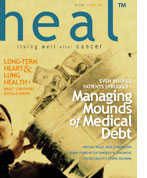Publication
Article
Heal
A Shot at Prevention
Author(s):
Vaccination against HPV might someday hold promise beyond fighting just cervical cancer
Gardasil, a long-awaited human papillomavirus vaccine, has been promoted as a way to prevent cervical cancer, a condition affecting 10,000 U.S. women each year. Yet because the virus affects other parts of the body, vaccination may eventually prove useful in fighting other types of cancer, perhaps even providing protection in men.
More than 100 types of the human papillomavirus are known. HPV 16, for example, is associated with cancers of the vulva, vagina, penis, anus, oral cavity and oropharynx (the area of the throat at the back of the mouth), notes Lauri E. Markowitz, MD, team leader for epidemiological research in the Sexually Transmitted Disease Division of the Centers for Disease Control and Prevention in Atlanta. The virus is also believed by some researchers to play a role in certain types of skin cancer, although research in this area is ongoing.
The issue of non-cervical HPV-related cancers made the news last spring when researchers at The Sidney Kimmel Comprehensive Cancer Center at Johns Hopkins found conclusive evidence that HPV is the cause of certain throat cancers among men and women. Reporting in The New England Journal of Medicine, the researchers found that oral HPV infection is the strongest risk factor for the disease, regardless of tobacco and alcohol use, and having multiple oral sex partners is one of several sex practices that boosts risk for the HPV-linked cancer.
The big question, of course, is whether Gardasil can also provide protection against this and other non-cervical types of HPV-related cancer. This is important because throat cancers typically are diagnosed at later stages and are therefore associated with poor survival rates, says Aimee Kreimer, PhD, an HPV epidemiologist in the Division of Cancer Prevention at the National Cancer Institute.
The potential multi-cancer effectiveness of Gardasil and other HPV vaccines in development is also of importance among gay men, for whom HPV-related anal cancer is a significant problem. (Gay or bisexual men are 17 times more likely to develop anal cancer than heterosexual men, according to the CDC.) Studies evaluating the efficacy of Gardasil and other HPV vaccines in men are yet to come, says Kreimer.
Some trials of Gardasil already have been conducted for precancers other than cervical. “The trials done so far have also looked at vulvar and vaginal precancers, and the vaccine provides protection against those as well,” notes Markowitz, adding that data are not available on the efficacy of the vaccine for prevention of anal, penile or oropharyngeal cancers.
Gardasil was hailed as a major advance in cancer prevention when it first became available to the public nationwide in 2006. It targets HPV types 6, 11, 16 and 18, with 16 and 18 being responsible for about 70 percent of all cervical cancers, says Markowitz. Types 6 and 11 are responsible for genital warts, as well as a rare disease known as recurrent respiratory papillomatosis.
About 10,000 cases of invasive cervical cancer are reported in the United States each year, and about 3,700 women die of the disease annually, according to the American Cancer Society.
HPV is the most common sexually transmitted infection in the United States and the primary cause of all cervical cancers.
“It has been calculated that 50 to 60 percent of women will have an HPV infection at some point in their lives,” notes Kreimer. “That sounds terrible, but the good news is that in most cases the infection clears, often with no symptoms. You don’t even know that you had it.”
HPV has a very strong affinity for basal cells, and when they become accessible, HPV can infect a single cell, which then clonally reproduces to create the excessive cells that eventually become a cancer.
However, persistent, long-term HPV infections can cause changes within the cells of the cervix, especially in a region known as the “transformation zone” where cell turnover is more rapid, resulting in an increased risk of cervical cancer.
“A woman’s cervical-vaginal epithelium has several layers of cells, and through a tiny scrape or tear, the HPV virus gains access to the basal cell layer, which is the bottom layer of cells,” explains Kreimer. “HPV has a very strong affinity for basal cells, and when they become accessible, HPV can infect a single cell, which then clonally reproduces to create the excessive cells that eventually become a cancer.”
Aiding this process, Kreimer says, are viral oncoproteins, which bind to human proteins that help regulate the normal cell cycle, allowing the cells to grow out of control.
The Pap test, a cervical cancer screening test, looks for the cellular abnormalities often caused by HPV. If the test is positive, a biopsy may be performed to identify a precancerous state known as cervical intraepithelial neoplasia, which can be monitored and treated when necessary.
“Fortunately, because screening is very effective in the United States, most women do not go on to develop cervical cancer,” Kreimer notes. “In fact, the rate for cervical cancer is quite low in this country compared to developing nations, where the disease is often the leading cause of cancer deaths in women.”
While HPV plays an integral role in the development of cervical cancer, there are probably other factors at work because so many women have the infection yet relatively few develop the cancer.
“Obviously, there is something going on in between,” notes Kreimer. “Researchers have debated whether nutrition, smoking or co-infections play some kind of a role. But HPV is a necessary cause,” meaning it has to be present for cervical cancer to develop.
The federal Advisory Committee on Immunization Practices (ACIP) recommends that Gardasil be routinely given to middle-school-age girls because it is most effective when received before sexual activity first occurs, notes Markowitz. “ACIP also recommends what we call a catch-up vaccination for women through age 26 who haven’t been vaccinated yet,” she adds.
How long the vaccine will protect against HPV remains unclear. Studies have suggested that protection extends at least five years, but further research is needed to determine whether booster vaccinations eventually will be required.
Public health authorities consider Gardasil safe, noting few reports of adverse reactions. According to the Vaccine Adverse Event Reporting System (VAERS), which is overseen jointly by the CDC and the Food and Drug Administration, one of the most common reactions seen among women receiving Gardasil is fainting, although any association between this reaction and the vaccine remains unknown.
“We know that adolescents tend to be more anxious and to faint more often after receiving vaccines than other age groups, so it’s unclear whether this is actually related to Gardasil or if it’s because more adolescents are getting vaccinated now,” Markowitz says.
"Researchers have debated whether nutrition, smoking or co-infections play some kind of a role. But HPV is anecessary cause,” meaning it has to be present for cervical cancer to develop. —AIMEE KREIMER
Gardasil is widely available, but to date its use has not been as high as public health officials would like because of a variety of factors. Cost is one — at $360 for the three-shot regimen, Gardasil is among the most expensive vaccines ever offered.
There has also been some controversy surrounding certain state proposals to make the vaccine a requirement for school entry.
“The controversy wasn’t about the recommendation, but about mandating the vaccine for school entry,” Markowitz says. “That is not something decided on the federal level; each state makes its own recommendations for vaccinations required for school entry. So far, only Virginia has mandated Gardasil’s use among middleschool students, but that mandate hasn’t gone into effect yet and there are several exemptions that are allowed.”
Gardasil will probably have company in the marketplace in the near future because a variety of other HPV vaccines are in development or under review by the FDA.
Notable is Cervarix, but the U.S. release of the drug was recently pushed back following an FDA request for additional information about clinical trials of the vaccine.
For women, the value of HPV vaccination is clear. Experts say that if administered as directed and in the appropriate populations, the vaccine has the potential to dramatically reduce the number of cervical cancers.
And one day, if current research confirms earlier studies, the same may well be said for a range of other potentially life-threatening HPV-related cancers.






